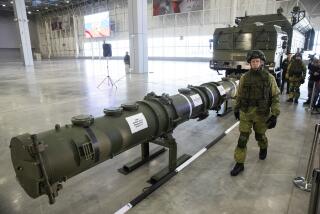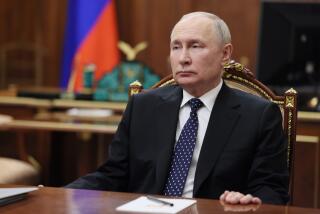Nuclear Arms Treaty Review Session Ends With Soviet Warning
- Share via
GENEVA — An eight-day meeting of senior U.S. and Soviet military officers to discuss compliance with nuclear arms treaties ended inconclusively Wednesday, and the Soviets warned of “extremely dangerous consequences” for the arms control process if President Reagan goes ahead with his declared intention to abandon the SALT II treaty.
A statement issued by the U.S. side announcing the conclusion of the meetings did not even mention the Administration’s stand on SALT II, although Reagan’s declaration that he is willing to abandon the unratified treaty triggered the Soviet request for this special session of the U.S.-Soviet Standing Consultative Commission.
Instead, the statement noted that the Soviet side rejected Reagan’s proposal to replace the 1979 strategic arms limitation treaty with “mutual restraint” until a new agreement can be reached on reductions in offensive weapons.
‘Deep and Equitable’ Cuts
“At this session, the Soviet Union rejected President Reagan’s call of May 27, 1986, for the Soviet Union to join the United States in establishing an interim framework of truly mutual restraint pending conclusion of a verifiable agreement on deep and equitable reductions in offensive nuclear arms,” the statement said. “The Soviet Union was informed that the call remains open.”
Because of the standoff, the only result of the discussions appears to have been to confirm that the commission will still hold its regular semi-annual session in Geneva at a date to be determined in the fall.
The commission was established under the 1972 Anti-Ballistic Missile Treaty and the first strategic arms limitation treaty to serve as a regular forum for complaints about compliance and arguments about interpretation of treaty provisions.
The Soviet warning of “dangerous consequences” if the Reagan Administration goes ahead with specific actions that would break the limitations in the SALT II treaty was contained in a statement circulated in Geneva by the Tass news agency.
‘Fundamentally Flawed’
In announcing his intention to stop observing SALT II, Reagan called on the Soviets to “correct their noncompliance, reverse their unwarranted military buildup and make progress at the Geneva negotiations,” the three-part talks due to resume in September. He also called SALT II “fundamentally flawed.”
The Reagan Administration has so far ordered the dismantling of two 20-year-old Polaris submarines in order to stay within the SALT II limits as new Trident submarines become operational. But now it is apparently preparing to increase the number of air-launched cruise missiles to be installed on B-52 bombers, without making a commensurate cut in other strategic nuclear warheads in the U.S. arsenal, and thus will exceed the warhead limit in the treaty.
Although the treaty was never ratified, both the United States and the Soviet Union say they have complied with its terms.
SALT II restricted each side to 2,250 intercontinental missiles and heavy bombers, with a sub-limit of 1,320 on missiles armed with multiple independent warheads. It also allowed only one new strategic missile apiece.
The State Department and a majority of U.S. senators oppose any abandonment of SALT II, particularly before a second summit meeting between Reagan and Soviet leader Mikhail S. Gorbachev. But the Pentagon has been urging the treaty’s abandonment almost since Reagan took office, and so far the President seems still to be leaning in this direction.
There is no particular deadline for a decision to add more cruise missiles to the B-52 bombers, although Pentagon sources in Washington have talked about November as a possible date. Such a move could have some diplomatic consequences if a summit meeting were then in the offing.
More to Read
Sign up for Essential California
The most important California stories and recommendations in your inbox every morning.
You may occasionally receive promotional content from the Los Angeles Times.










